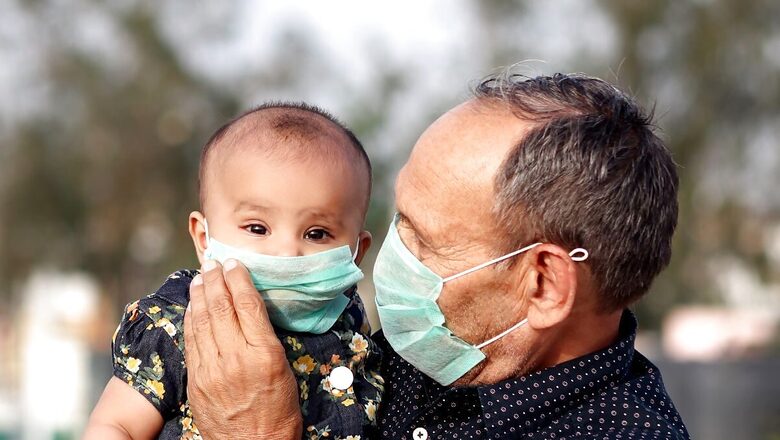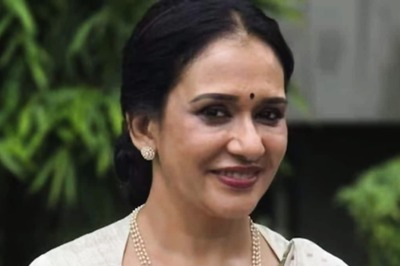
views
Some days were full of grief, anxiety, and stress whereas others were hopeful, exciting, and encouraging.
Plasma therapy, Acalabrutinib, Tocilizumab, Dexamethasone or Coronil, Ashwagandha, and Giloy – I tried to find hope in everything I was reporting about.
When last week, the World Health Organization (WHO) declared that Covid-19 no longer represents a “global health emergency”, it suddenly took me back to the evening of March 24, 2020, when Prime Minister Narendra Modi announced the first lockdown. We hardly knew our lives were about to change and they did change, for quite a long period.
Calling experts at wee hours to ask for help in understanding studies published in medical journals to reading clinical trial protocols, recognising the importance of peer-reviewed studies, and separating science from pseudo-science, every day was a new learning.
From A to Z, here is an encapsulated journey of the Covid-19 trajectory in India.
Airborne or not?
Early in the pandemic, the World Health Organization stated that novel coronavirus was not transmitted through air. “FACT: COVID19 is NOT airborne,” the global health body said in March that year.
However, later, a group of scientists made the UN agency change its stand. By April 2021, the WHO quietly updated a page on its website, acknowledging that the virus can spread via aerosols as well as larger droplets.
Black fungus
By the end of the second wave in 2021, in the month of May and June, India registered thousands of cases of a rare fungal infection in recovered Covid-19 patients. Among other reasons, the indiscriminate use of oral steroids in the treatment of these patients was being blamed for the spurt in cases.
The families of patients jostled to find the drug Liposomal Amphotericin B which treats black fungus.
Coronil Patanjali
Baba Ramdev, in June 2020, launched the Covid-19 kit — a pack comprising three products, including a medicine named Coronil — and touted it as a “cure” for the novel coronavirus. Interestingly, Covid-19 still has no known cure despite researchers worldwide toiling in its pursuit.
However, the Patanjali product ran into controversy over the absence of proper clinical trial data to back its claim. Ramdev also said Coronil had WHO certification and the product was promoted by then Union health minister Harsh Vardhan.
Delta Wave
India faced a severe surge in Covid-19 cases during the second wave, which began around February 2021 and peaked in April-May 2021. The Delta variant, a highly transmissible variant of the SARS-CoV-2 virus, was identified as the primary driver of the second wave in the country.
During this wave, India witnessed a rapid increase in daily cases, overwhelming the healthcare system in many regions. Hospitals faced shortages of beds, medical oxygen, and essential medications. Many areas experienced a shortage of vaccines, testing kits, and other medical supplies.
The surge in cases led to an increased demand for medical resources, particularly oxygen, which became a critical issue. The second wave of Covid-19 in India had a significant impact on the country, with a high number of cases and fatalities reported.
Endemic
The novel coronavirus is now showing classic traits of movement towards endemicity, former Indian Council of Medical Research (ICMR) scientist Dr Raman Gangakhedkar told News18 over the latest surge in Covid-19 cases across India.
Covid is likely to become an endemic – a disease which regularly occurs within an area or community – like the flu.
Experts believe that coronavirus is already on its way out and hence causing mild infections but low deaths and hospitalisation rates when compared to pre-Omicron variants.
The classic traits of a virus moving towards endemicity from a pandemic include the phenomenal fall in its lethality and a noticeable surge in its ability to cause infections.
Frontline workers
Frontline workers played a crucial role in managing and responding to the Covid-19 pandemic across the globe. The data collected by the Indian Medical Association estimates that around 1,800 doctors succumbed to the infection — 757 during the first wave, 839 during the second wave and the rest later.
Other frontline individuals work in various sectors and professions, including emergency services, public health, and essential services. For instance: Laboratory technicians, who were medical laboratory professionals and technicians conducting tests to detect Covid-19 infections or social workers providing support to individuals and communities affected by the pandemic.
Government & ‘Gharelu Nuskhe’
All government organisations were working day and night to ensure smooth management and advance preparations against Covid-19, especially the Ministry of Health and Family Welfare and the Department of Pharmaceuticals under the Ministry of Chemicals and Fertilizers.
The government also promoted the use of traditional medicines apart from building strong-science based products.
From sipping hot turmeric milk, decoctions, to Giloy and Ashwagandha, the Ministry of AYUSH promoted the use of Ayurveda, claiming that alternative medicines can help improve immunity against the novel coronavirus. Prime Minister Narendra Modi also promoted the advice from the ministry in his address to the nation in April.
HCQ
The Indian Council of Medical Research (ICMR), the country’s apex medical research body, found that consuming the drug Hydroxychloroquine (HCQ) reduces the chances of getting infected with Covid-19.
As a result, ICMR released an advisory in March and then in May 2020 to expand the usage of HCQ — an anti-malarial drug — as a preventive treatment against the novel coronavirus.
ICMR had issued an advisory to begin using HCQ in March, but it had drawn criticism for lacking scientific evidence that the drug works against the novel coronavirus. One year later, the agency removed usage of HCQ from the treatment protocol.
Immunity
As the pandemic struck India, ‘immunity’ became the buzzword.
According to data on the Google Ads console, the monthly search volume for the term ‘immunity boosters’ stood at 6,600 in January 2020, when there was no Covid-19 case in India. On January 30, India confirmed its first case of Covid-19.
As paranoia kicked in, the searches for immunity boosters multiplied. From 8,100 in February to 90,000 in March 2020 and 1.65 lakh in July, Indians started their run to fine-tune their immunity, starting with popping multivitamins. For instance: Sales of Zinc supplement Zincovit increased by 93 per cent with a total of 54 crore tablets sold in 2020 while that of Vitamin C grew 110 per cent with around 185 crore pills being sold in 2020 against 2019.
Jabs
The Drug Controller General of India (DCGI) announced approval for the restricted emergency use of the novel coronavirus disease (Covid-19) vaccines manufactured by Bharat Biotech International Ltd and Serum Institute of India on January 3, 2021.
India opened its vaccination drive on January 16, 2021, in a phased manner where healthcare workers and older individuals were prioritised. The country also faced vaccine hesitancy in the beginning among certain sections which was resolved to a large extent later on.
By the end of the year, on December 25, PM Modi announced precautionary doses — a term coined by India for booster shots or third doses.
By then, India had multiple vaccines available that were offered for “heterologous boosting”, including Novavax’s Indian version of Covovax and Biological E’s Corbevax apart from homologous boosters.
Kerala Model
During the first wave of Covid-19 infections, Kerala successfully managed to contain the pandemic and as a result, the Kerala model was celebrated as a success story across the globe.
According to a paper published by United Nations University World Institute for Development Economics Research in June 2022, “it is true that by incorporating the test, trace, and isolate strategy in a stringent manner Kerala initially succeeded in flattening the curve, but it gave way to premature celebrations”.
However, the paper also highlighted the failure to contain the spurt in Covid-19 infections in the state during the second wave. “…This instilled a false sense of security in the minds of people and the government and eventually Kerala became a victim of its own success. While the rest of India recovered from the second wave of Covid-19 infections, Kerala struggled to bring the pandemic under control.”
Long Covid
According to America’s CDC, long Covid-19 is broadly defined as signs, symptoms, and conditions that continue or develop after the initial coronavirus infection.
There is no test that determines if the symptoms or conditions are due to Covid-19. Difficulty in breathing or shortness of breath, cough, tiredness, depression, digestive symptoms, changes in menstrual cycles, pounding heart, pins-and-needles feelings, and changes in smell and taste are some of the wide range of health problems counted as long Covid.
These long-term side effects do not resolve even after weeks, months, or in some cases, years of recovery and is an area where researchers are still trying to learn more.
Mental Health
The stress, uncertainty, and fear associated with the pandemic exacerbated mental health issues or created new ones. The isolation and disruptions increased the feelings of anxiety and depression.
Grief, memories of those who passed away due to Covid-19, insomnia, and behavioural changes among children were also some of the top concerns that were discussed by callers on the 24×7 helpline set up by the National Institute of Mental Health and Neurosciences (NIMHANS) in Bengaluru.
The Covid-19 pandemic has increased the visibility and importance of mental health and, at the same time, shown us the need to strengthen services for the same.
N-95 masks, PPE and testing kits
In the initial stages of the outbreak, India was barely producing anything, including PPE kits, masks or testing kits.
The manufacturing of these equipment were soon jacked up by the government. The production of N-95 masks and PPE kits — the first line of defence against Covid-19 — was boosted by the end of the year and India became the second-largest manufacturer of PPE kits across the world.
Oximeter
By now, everyone is familiar with the device that played a critical role in assessing the health status of Covid-19 patients, especially when in home isolation.
A small clip-on device, it assesses oxygen levels in blood and heart rate. Since Covid-19 impacts the lungs, oxygen levels in the blood are considered a key indicator of mild or severe disease. The sale of the device soared by the second wave and prices went above Rs 3,000. They are now back to around Rs 600 on online and offline platforms.
Pfizer & Moderna
In December 2020, Pfizer became the first drugmaker to apply for an emergency use authorisation for its Covid-19 vaccine in India.
However, the top government officials later revealed that Pfizer’s mRNA Covid-19 vaccine could not be brought to India as the pharmaceutical giant demanded indemnification and sovereign immunity waiver, while Moderna, too, insisted on an indemnity clause.
Top government sources had earlier told News18.com about the immense pressure from all sides to buy Pfizer and Moderna vaccines, with foreign manufacturers offering them at $30 each.
Quarantine and Isolation
Quarantine measures during the pandemic presented numerous challenges and were not easy for many. Quarantine involved staying at home or in designated facilities for a specific period, limiting social interactions, and adhering to strict guidelines to minimise the spread of the virus. This in turn led to loneliness, financial impact and mental health struggles.
Remdesivir
The name of this drug has been etched in the minds of many people who lost their loved ones. It was the last week of April when India was in the middle of a terrible second wave of Covid-19. Every possible communication platform — including Twitter, Facebook, Instagram and WhatsApp status messages — was flooded with emotional appeals to find plasma donors or Remdesivir.
During the second wave, Remdesivir was being prescribed as an experimental drug. Soon, it was widely available in the black market and was sold as high as Rs 60,000 per vial.
The WHO’s solidarity trial, conducted in 405 hospitals in 30 countries on patients hospitalised with Covid-19, showed that 2,750 patients on Remdesivir were as likely to die as 2,708 patients on standard care. The drug did not reduce mortality or the time Covid-19 patients take to recover.
In the DisCoVeRy trial, sponsored by the government of France, European Union Commission and others, the drug showed no clinical benefit.
Sanitisers
The demand for sanitisers reflected the status of paranoia or complacency in public due to the pandemic.
In March 2019, revenue from the sales of sanitisers stood at Rs 2.2 crore which increased to Rs 3.3 crore in March 2020, post the Covid-19 outbreak in India. By September 2020, when the first wave peaked, revenue grew to Rs 49.3 crore — a jump of 24 times when compared to pre-pandemic sales.
It then soared to Rs 59.1 crore in May 2021, during the peak of the second wave. However, by August 2021, its sales plummeted to Rs 33.9 crore.
Tele consultancy
During the lockdown, OPDs in the country were closed. The government, in sync with the release of telemedicine practice guidelines, conceptualised a version of eSanjeevani for Patient-to-Doctor telemedicine.
On April 13, 2020, eSanjeevaniOPD was launched to facilitate the provision of health services for patients in the confines of their homes. Alongside, several other private players launched tele and video consultation, familiarising Indians with the concept of virtual consultations, e-prescriptions and digital health records.
The government has achieved the landmark of 10 crore tele-consultations on eSanjeevani app till February this year.
Unprecedented
The development and manufacturing of vaccines for Covid-19 has been an unprecedented feat globally. India won this challenge and manufactured vaccines not only for its own people but also for various other countries at affordable rates.
India also ended up making mRNA, intranasal as well as the world’s first plasmid DNA vaccine against Covid-19, apart from the traditional vaccines.
The extraordinary accomplishment was the speed and the development of vaccines which usually takes several years.
Virus origin conspiracy theories
The origin story of Covid-19 remains murky.
Three years after the start of the pandemic, it’s still unclear whether the novel coronavirus leaked from a lab or spread to humans from an animal.
While the lab leak theory has been doing the rounds on the internet since the pandemic began, this year in March, the most popular theory — the Wuhan lab leak claim — made a comeback when Federal Bureau of Investigation (FBI) director Christopher Wray told Fox News that the FBI believed it was most likely caused by a “potential lab incident” at a Chinese government-controlled facility in Wuhan.
“The FBI has for quite some time now assessed that the origins of the pandemic are most likely a potential lab incident in Wuhan,” Wray said.
World Health Organisation
India and the UN agency WHO have been at loggerheads over severely mismatching death figures due to Covid-19.
The Ministry of Health and Family Welfare (MoHFW) had issued a rebuttal to the WHO’s estimate of 47 lakh excess deaths due to Covid-19 in India till 2021.
WHO stated that India has undercounted its death numbers by about a factor of 10. At that time, the official death figures stood at 5.24 lakh.
XBB
XBB 1.16 – This was the latest variant responsible for pushing the cases up. Experts believe that XBB.1.16 is a recombinant virus, which is made accidentally in human bodies. Recombinant viruses are generally not stable, unlike evolving escape mutants that confer higher viral fitness in mutating viruses in the lineages. They are made when two different variants enter the human body and there is a mix-up of genetic material during reproduction.
Yearning for normalcy
Also known as pandemic fatigue, it is a common sentiment shared by many people who have experienced the challenges and disruptions brought about by the pandemic.
People wanted to resume activities such as socialising freely, attending events, travelling without restrictions, and experiencing a sense of normalcy in daily life.
Zoom
As millions of people around the globe were pushed by the pandemic to stay at home to curb the spread of coronavirus, meeting people virtually was the only option.
The biggest beneficiary of the pandemic outbreak apart from drug manufacturers was Zoom, one of the dozens of video conferencing services, which rose to the top in the last few years. The concept of virtual meetings became popular and people became more comfortable working on Zoom calls and meetings.
In 2020, according to Bernstein Research and Apptopia, daily downloads of the Zoom app increased 30 times year-over-year starting in March. Zoom also said their daily users rose to 20 crore in March, up from 1 crore in December.
While Covid-19 will keep looking for those with weaker immune systems and we still cannot call it a wrap, the last three years have shown the importance of putting a strong healthcare system in place. The rude reality is — only the fittest will survive.
Read all the Latest India News and Karnataka Elections 2023 updates here




















Comments
0 comment